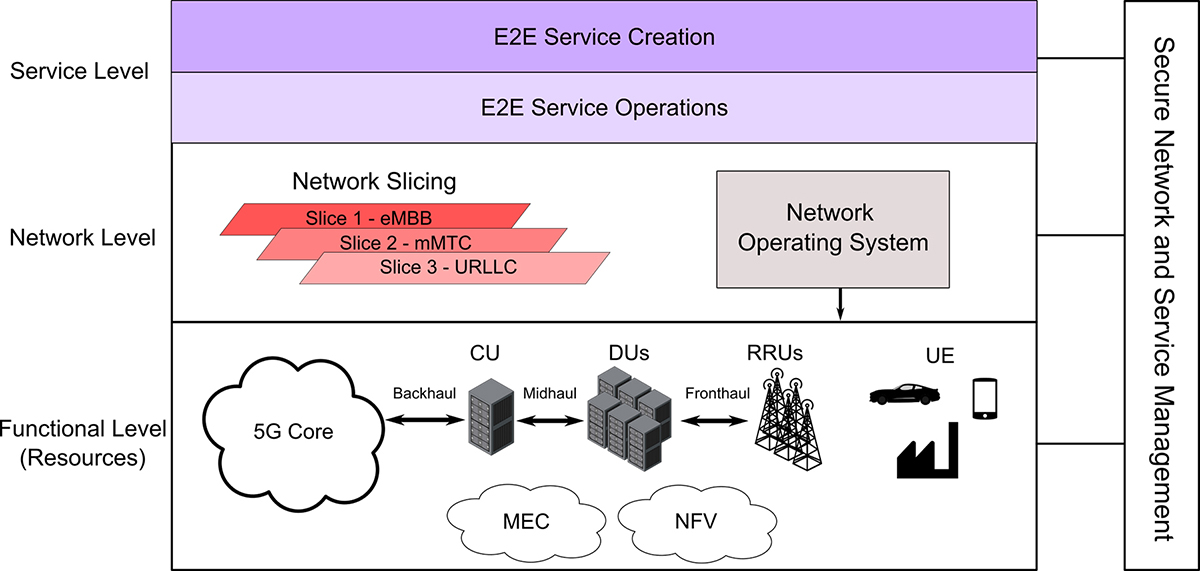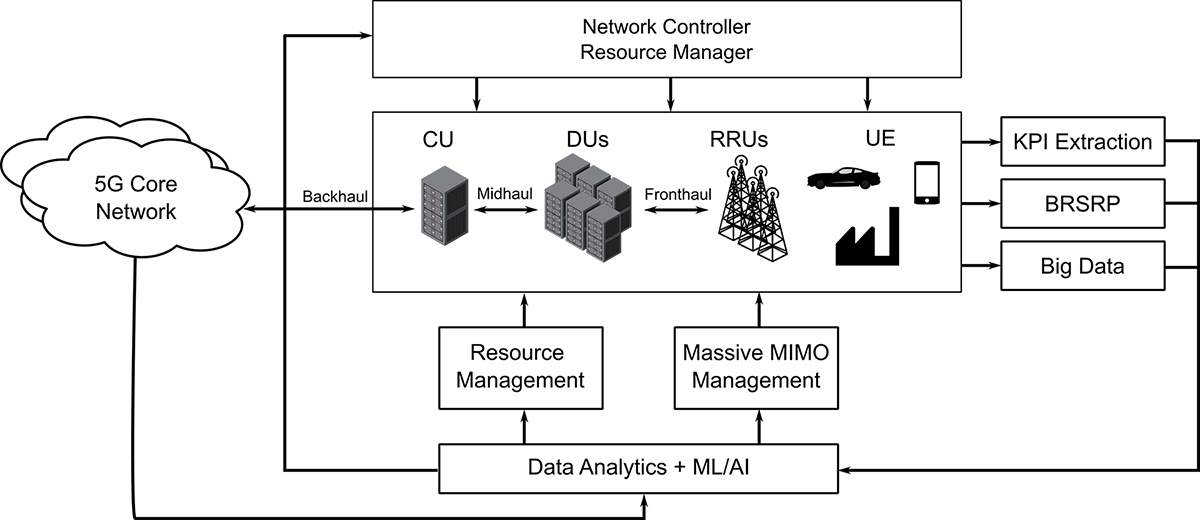Story
July 22, 2022

The main structure of a 5G network is the radio access network (RAN), which can be implemented in several architectures. Regardless of the architecture, software-defined radios (SDRs) play a major role in every step of the RAN chain, including backhaul, midhaul, and fronthaul. SDRs – whether on the battlefield or the urban jungle – provide important technological features that handle the “big data” glut, including fast 10-100 Gb/sec fiber communication, wide tuning range, several multiple-input/multiple-output (MIMO) channels, high phase coherence, and a software-based backend that can be programmed to fit any application.
The term big data is used to designate a massive amount of data collected from many different sources and the statistical tools and techniques designed to analyze these data sets, typically based on cloud/edge computing, machine learning (ML), and artificial intelligence (AI ). Collecting the massive amounts of information required to collect and use big data is no easy task.
A wide variety of wireless devices – often called user equipment (UE) – operate on large 5G networks, including autonomous vehicles, smartphones, and IoT [Internet of Things] devices. Extraction of big data from the multiple UEs and the further information processing through statistical analysis and ML/AI algorithms provide the perfect framework for several useful network operations, including optimization of device gateways, spectrum-sharing and dynamic spectrum access in networks, and real- time performance diagnostics and analytics on IoT networks, including the evaluation of key performance indicators (KPI). However, to properly enable big data, the UEs and the network must provide very high data throughput, low-latency backhaul, and optimized data storage.
Typically, the communication modules in baseband units (BBUs) and radio head units (RRUs) are based on software-defined radios (SDRs); therefore, the performance of these SDRs is one of the main bottlenecks in wireless big data collection. In this context, ultra-low latency and very high-performance SDRs are increasingly being adopted in 5G base stations, particularly due to the truly parallel signal processing (powered by FPGA [field-programmable gate array] technology) and their very high data throughput capability over Ethernet fiber, enabling extraction, processing, and packetization of vast amounts of data.
The FPGA-based digital backend can also easily implement big data functions and analytics inside the SDR. Furthermore, as the number of UEs connected on LTE/5G increases, these frequency bands become more and more congested and scarce, so smart radio resource allocation and spectrum-sharing policies can significantly improve the electromagnetic (EM) performance of a network. Both techniques require wideband spectrum monitoring, which can only be implemented using high-performance SDRs, with MIMO capabilities, ultra-low latency, wide bandwidths, and high tuning ranges.
The 5G future
Unlike the current 4G/LTE technology, 5G is intended to be much more than a simple data pipe. In fact, 5G networks can be seen as purpose-built networks designed to facilitate the connection between many devices, sensors, and automation systems. By providing more than ten times the capacity of 4G, 5G can ensure high levels of interconnectivity for the needs of military, government, and commercial devices, transmitting massive amounts of data with a high bit rate and ultra-low latency. This connectivity power is crucial for a variety of purposes, such as augmented reality (AR), virtual reality (VR), autonomous systems, tactile internet, and automation.
Despite the technological revolution that 5G is ushering in, there are several challenges that must be addressed and solved to unleash its full potential. The main bottleneck of 5G implementation is the network infrastructure. Although part of the backbone of the network can be implemented with the telecommunication infrastructure already in use, true 5G requires large numbers of small cells in densely populated areas to support the massive traffic of data, each working with wireless and fiber links with speeds greater than 10 Gb/sec and latencies smaller than 1 ms. Furthermore, the high frequencies necessary to provide enough bandwidth for high data rate users (> 6 GHz) is significantly problematic in terms of RF signal quality. For instance, high frequencies have a shorter range due to the signal loss and can be easily obstructed by obstacles (including buildings, walls, and trees), so they require large numbers of small cells to increase the coverage.
Fortunately, the use of multiple-input/multiple-output (MIMO) SDRs can simplify the implementation of highly dense small-cell networks, addressing both bandwidth and coverage. Finally, network security is much more concerning in 5G than 4G, due to the tight integration with critical systems including autonomous systems and vehicles: Therefore, dedicated security schemes are required to ensure the robustness of 5G networks, particularly considering the privacy issues in big data applications.
The high bandwidth and low latency of 5G networks, combined with the implementation of multi-access edge computing (MEC) architecture, creates the perfect environment for collecting and processing RF big data. The main idea consists of extracting as much data as possible from the densely packed small cells, applied in massive machine type communication (mMTC) and machine-to-machine communications (M2M) in IoT, and convert this big data into real-time insights for intelligent decision-making, using distributed computing architectures and high-performance network links, that can be further applied in quality of service (QoS) evaluation and optimization. For instance, big data can be used as a tool for operators to forecast the curve of demand, coordinate on-the-fly resource allocation and network slicing, and solve interference and coverage limitations by optimizing network capacity. Furthermore, 5G’s improved interconnectivity will enable distributed edge computing on a completely new level, with all the heavy big data computation performed in the cloud. (Figure 1.)

[Figure 1 | Overall 5G architecture on a service, network, and functional level.]
SDRs in 5G networks
As the name suggests, software-defined radios are RF units that implement most of the signal processing and communication functions in the digital domain, leaving only the essentials to the analog circuit. The general architecture of an SDR consists of an analog front end (AFE) and a digital back end. The AFE contains both the receive and transmit functionalities, and can be composed of several channels in MIMO operations. Each AFE channel can be tuned over a wide range of frequencies, including the 5G tuning range. The analog signals amplified and filtered by the AFE are digitized using dedicated ADCs and DACs with high and stable phase coherence. However, the real crux of the SDR is the digital backend, which is typically implemented using high-end FPGAs. The FPGA, with onboard DSP capabilities, is responsible for basic radio functions, such as modulation/demodulation, upconverting/downconverting, and filtering, but it can also perform complex communication tasks, including the latest 5G communication protocols and DSP algorithms. Moreover, it can packetize and transport Ethernet packets over 10 to 100 Gb/sec via SFP+/qSFP+ links. The FPGA-based backend enables the SDR to be designed for a wide range of SWaP (size, weight and power) requirements.
SDRs are the main building blocks of the general 5G RF network. They can be implemented as the fronthaul network in RRUs to receive and transmit data from the user equipment, or as the BBUs, particularly the distributed units (DUs) and central units (CUs) in the O-RAN network standard. In fact, SDRs can be applied in any step of the network chain, playing important roles in the midhaul and backhaul as well. Furthermore, they are the ideal technology to combine RRU and BBU functionalities in femto cells (small, low-power cellular base stations) by providing an off-the-shelf solution with high flexibility, low power consumption, and small form factor. An SDR-based femto cell can be used in a variety of applications, including wireless networks for tactical use or embedded communications systems for unmanned aerial systems (UASs).
Big data-driven AI/ML and SDR
Because of its affinity with software-based technology, SDRs can facilitate several technologies related to big data and artificial intelligence/machine learning (AI/ML) algorithms. For instance, SDRs can be used to test key performance indicators (KPI) of the 5G network. The high speed of reconfigurability required to rapidly manage network slicing (NS) can easily degrade the KPIs of the network. In this context, KPI monitoring and evaluation techniques, such as Autonomous Anomaly Detection (AAD) and real-time analysis, are fundamental to maintain the QoS. These techniques can be easily implemented using SDRs, by taking advantage of the digital backend and using the FPGA to run sophisticated KPI analysis algorithms in loco.
Due to the high amount of different devices and services that a 5G RAN [radio access network] must handle, network slicing is mandatory. To create these self-contained slices, SDN/NFV techniques are required, providing enough flexibility and reconfigurability over the physical layer of the network. SDRs play a major role in the softwareization of the network, enabling the implementation of SD-RAN algorithms, such as real-time RAN intelligent controllers (RIN). Furthermore, big data-driven dynamic slicing can take real-time information about the network state and automatically reallocate resources based on traffic predictors and dedicated cost functions. (Figure 2.)

[Figure 2 | A diagram shows how data-driven AI/ML can help a radio access network (RAN).]
Data-driven ML/AI algorithms can also be used in beamforming optimization, by assisting the RRUs to calculate and select the best beams to maximize the reference signal received power (RSRP). In this case, the beamforming process will take the form of a data-driven feedback system, where each UE informs the serving cell about several beam parameters, including beam index (BI) and beam reference signal received power (BRSRP), which then makes a decision about which beams must be selected to serve that unit. With the massive number of UEs in use, this becomes a big data problem. By promoting softwareization of the RRU and providing MIMO capabilities to drive the antenna arrays, SDRs actually enable beamforming optimization via big data. Furthermore, in massive MIMO applications, each beamforming antenna receives a weight that must be optimized to obtain the best beam. ML/AI algorithms can be used to dynamically optimize the weight of the antennas based on forecast models, historical data, interference data, and user specifications.
Brendon McHugh is a field application engineer and technical writer at Per Vices, a company that develops, builds, and integrates software-defined radios (SDRs). Brendon is responsible for assisting current and prospective clients in configuring the right SDR solutions for their unique needs. He holds a degree in theoretical and mathematical physics from the University of Toronto. Readers may contact Brendon at [email protected].
Kaue Morcelles is a technical writer and is a Ph.D. student in electrical engineering.
Per Vices • https://www.pervices.com





